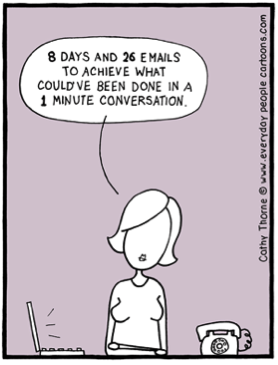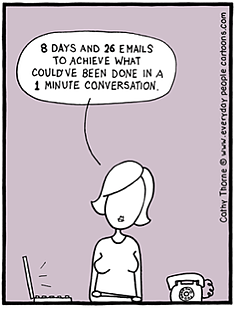CEO Blog - Advice for CEOs on growth and scaling
Email Is Not Always Your Friend – Three Ideas for Better Management

It’s Not Just a Problem of Volume

The immense volume of email that many of us receive each day can make email seem like an unbeatable adversary in a battle between responding to messages and getting the work done that we had planned. It is always a bit impressive, therefore, when people come up with a system for dealing with email overload that actually works for them. For instance, Both Zappos CEO Tony Hsieh and LinkedIn CEO Jeff Weiner have developed their own systems for handling email and staying productive rather than email being a constant, nagging drag on his day. Their systems won’t work for everyone, but they are good examples of taking a systematic approach to email.
Not all problems with email communication are volume related. Because email is so pervasive and so immediate, it seems like we should use it for everything. There are, however, things that we shouldn’t do by email.
Keep it Short and Simple
Email is at its best when sharing simple, specific information. If you have a quick question or are providing a short update on a project, email is the way to go. Email is perfect for sending out a brief request, simple instructions or to clear a to-do list. It is also a great way to get information to multiple people that they need to read, process and refer back to (for example, agenda topics for an upcoming meeting). When the message is simple, straightforward information that doesn’t require much (if any) discussion, explanation or deliberation, then email is the way to go.
As the communication becomes more complex, however, consider picking up the phone or scheduling some face-to-face time rather than defaulting to email.
- Don’t use email for complicated instructions that are likely to generate questions or require further explanation.
- Avoid long, complex emails. When the message is lengthy, difficult and complicated, email can make a mess of it. If you find yourself taking a long time to write and edit an email, then you probably shouldn’t be using email.
- People are less likely to read a message that is more than a brief paragraph or two. Just think how often you’ve received a long email and said, “I’ll read that one later,” and later never comes.
- Don’t use email for solving complex problems or problem solving that involves multiple people. You are more likely to produce a jumble of increasingly confusing email threads than workable solutions.
When Time is Critical, Pick up the Phone
When time is critical, pick up the phone to get the information or the action you need when you need it. Even though electronic media moves a message from Point A to Point B in an instant, it doesn’t guarantee that a message gets from Person A to Person B in an instant.
We have all experienced the frustration of sending an email asking for information that we need now—and waiting. And waiting. And waiting. Be realistic: even in today’s always-connected world, I may not get your message in time to be helpful to you. Additionally, writing styles don’t always convey the same sense of urgency; I may not pick up that your need is any more critical than that of the other 50 emails I received in the last 10 minutes. The best way to deal with urgency is by phone or face-to-face.
Beware Danger in REPLY ALL, SEND and FORWARD
Don’t use email when you need to communicate bad news, complaints, criticism or negative feedback—or anything that is sensitive or controversial. Misunderstandings and hurt feelings result more easily without the benefit of facial expressions, intonation and body language—and strong emotions are more likely to escalate.
Additionally, always remember that the FORWARD button is very easy to use—and incredibly tempting when people are upset or when the information is just too good (or too bad) not to share. Don’t use email when information is extremely sensitive, when the message is confidential or if you do not want to have a permanent record of the message. Once you send an email, you can never get it back, and you lose all control of what happens to it. You simply have no way of knowing where an email message will end up. A good rule of thumb: never put anything in an email that you wouldn’t want to see on the front page of the newspaper! Email is a part of our tool set – but it’s not always the wisest solution across the board for effective communication. It seems patently obvious, but sometimes a person to person voice does more to create a bond and communicate intent than any well-crafted email ever could. Try it.
Topics: Communication
Wed, Sep 11, 2013- Press Releases
- Careers
- Case Studies
- Marketing Consultant Company
- Marketing Strategy Consultants
- Marketing Plan Consultants
- B2B Marketing Consultants
- Virtual CMO
- Marketing Consultant Outsourcing
- Fractional CMO
- What is a Fractional CMO
- Healthcare Marketing Consultant
- Marketing Consultant Houston TX Texas
- Marketing Consultant Texas TX
- Marketing Consultant Bay Area
- CEO Blog
- Ebooks Plus
- Executive Marketing Consultants
- Product Marketing Consultants
- B2C Marketing Consultants
- Virtual Marketing Consultants
- Senior Marketing Consultants
- Temporary CMO
- Hire a CMO
- Fractional CMO Salary
- Fractional CMO Responsibilities
- Marketing Consultant Austin TX Texas
- Marketing Consultant Dallas TX Texas
- Marketing Consultant San Antonio
- Helping Private Equity
- Private Equity Blog
- Leadership Team
- Privacy Policy
- Business Marketing Consultants
- Strategic Marketing Consultants
- Marketing Technology Consultants
- Sales and Marketing Consultants
- CMO Job Description
- CMO Salary
- Fractional CMO Agency
- Fractional CMO Services
- CPG Marketing Consultant
- Marketing Consultant San Diego
- Partners
Houston, TX 77056
© 2023 Chief Outsiders


